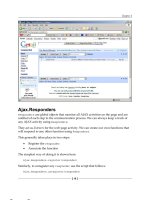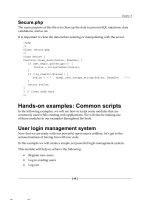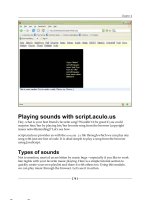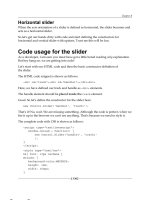O’Reilly Radar Web 2.0 Principles and Best Practices pot
Bạn đang xem bản rút gọn của tài liệu. Xem và tải ngay bản đầy đủ của tài liệu tại đây (218.36 KB, 9 trang )
O ’ R E I L L Y R A D A R
Web 2.0
Principles and Best Practices
John Musser
with Tim O’Reilly
& the O’Reilly Radar Team
Contents
Executive Summary . . . . . . . . . . . . . . . . . . . . . . . . . . . . . . . . . . . . . . . . . 7
Section I: Market Drivers of Web 2.0 . . . . . . . . . . . . . . . . . . . . . . . . . . 8
Six Key Market Drivers . . . . . . . . . . . . . . . . . . . . . . . . . . . . . . . . . . . . . 8
Section II: Ingredients of Web 2.0 Success . . . . . . . . . . . . . . . . . . . 12
The Eight Core Patterns . . . . . . . . . . . . . . . . . . . . . . . . . . . . . . . . . . . . 12
Web 2.0 Patterns and Practices Quick Reference . . . . . . . . . . . . . . . . . . 14
Section III: Web 2.0 Exemplars . . . . . . . . . . . . . . . . . . . . . . . . . . . . . . 57
Web 2.0 Profile: Amazon.com . . . . . . . . . . . . . . . . . . . . . . . . . . . . . . . . 60
Web 2.0 Profile: Flickr.com . . . . . . . . . . . . . . . . . . . . . . . . . . . . . . . . . 72
Section IV: Web 2.0 Assessment . . . . . . . . . . . . . . . . . . . . . . . . . . . . 80
Appendix A: Web 2.0 Reading List . . . . . . . . . . . . . . . . . . . . . . . . . . . 88
Appendix B: Technologies of Web 2.0 . . . . . . . . . . . . . . . . . . . . . . . 91
Endnotes . . . . . . . . . . . . . . . . . . . . . . . . . . . . . . . . . . . . . . . . . . . . . . . . . . . 94
O’Reilly Media Inc.
Web 2.0 Principles and Best Practices, Fall 2006
Introduction
In 2004, we realized that the Web was on the cusp of a new era, one that would
nally let loose the power of network eects, setting o a surge of innovation and
opportunity. To help usher in this new era, O’Reilly Media and CMP launched a
conference that showcased the innovators who were driving it. When O’Reilly’s
Dale Dougherty came up with the term “Web 2.0” during a brainstorming session,
we knew we had the name for the conference. What we didn’t know was that the
industry would embrace the Web 2.0 meme and that it would come to represent
the new Web.
Web 2.0 is much more than just pasting a new user interface onto an old applica-
tion. It’s a way of thinking, a new perspective on the entire business of software—
from concept through delivery, from marketing through support. Web 2.0 thrives
on network eects: databases that get richer the more people interact with them,
applications that are smarter the more people use them, marketing that is driven
by user stories and experiences, and applications that interact with each other to
form a broader computing platform.
The trend toward networked applications is accelerating. While Web 2.0 has ini-
tially taken hold in consumer-facing applications, the infrastructure required to
build these applications, and the scale at which they are operating, means that,
much as PCs took over from mainframes in a classic demonstration of Clayton
Christensen’s “innovator’s dilemma” hypothesis, web applications can and will
move into the enterprise space.
Two years ago we launched the Web 2.0 Conference to evangelize Web 2.0 and
to get the industry to take notice of the seismic shift we were experiencing. This
report is for those who are ready to respond to that shift. It digs beneath the hype
and buzzwords, and teaches the underlying rules of Web 2.0—what they are, how
successful Web 2.0 companies are applying them, and how to apply them to your
own business. It’s a practical resource that provides essential tools for competing
and thriving in today’s emerging business world. I hope it inspires you to embrace
the Web 2.0 opportunity.
—Tim O’Reilly, Fall 2006
4Executive Summary
Executive Summary
Web 2.0 is a set of economic, social, and technology trends that collectively
form the basis for the next generation of the Internet—a more mature,
distinctive medium characterized by user participation, openness, and
network effects.
Web 2.0 is here today, yet its vast disruptive impact is just beginning. More than just
the latest technology buzzword, it’s a transformative force that’s propelling companies
across all industries toward a new way of doing business. Those who act on the Web
2.0 opportunity stand to gain an early-mover advantage in their markets.
O’Reilly Media has identified eight core patterns that are keys to understanding and
navigating the Web 2.0 era. This report details the problems each pattern solves or
opportunities it creates, and provides a thorough analysis of market trends, proven
best practices, case studies of industry leaders, and tools for hands-on self-assessment.
To compete and thrive in today’s Web 2.0 world, technology decision-makers—
including executives, product strategists, entrepreneurs, and thought leaders—need
to act now, before the market settles into a new equilibrium. This report shows you
how.
What’s causing this change? Consider the following raw demographic and techno-
logical drivers:
One billion people around the globe now have access to the Internet
Mobile devices outnumber desktop computers by a factor of two
Nearly 50 percent of all U.S. Internet access is now via always-on broadband
connections
Combine drivers with the fundamental laws of social networks and lessons from the
Web’s first decade, and:
In the first quarter of 2006, MySpace.com signed up 280,000 new users each
day and had the second most Internet traffic
By the second quarter of 2006, 50 million blogs were created—new ones
were added at a rate of two per second
In 2005, eBay conducted 8 billion API-based web services transactions
These trends manifest themselves under a variety of guises, names, and technologies:
social computing, user-generated content, software as a service, podcasting, blogs,
and the read–write web. Taken together, they are Web 2.0, the next-generation, user-
driven, intelligent web. This report is a guide to understanding the principles of Web
2.0 today, providing you with the information and tools you need to implement Web
2.0 concepts in your own products and organization.
•
•
•
•
•
•
5 Web 2.0 Principles and Best Practices
When devices and programs are connected to the Internet, applications are
no longer software artifacts, they are ongoing services. This has significant
impact on the entire software development and delivery process. Therefore,
don’t package up new features into monolithic releases, but instead add
features on a regular basis as part of the normal user experience. Engage
your users to be real-time testers, and structure the service to reveal how
people use your product.
Overview: End of the Software Adoption Cycle
“What version of Google is this?” Millions of customers use Google’s software every
day yet never have cause to ask this question. Why? Because In the Internet era, users
think in terms of services not packaged software, and they expect these services to
just be there and to improve over time. No versions, no installations, no upgrades
needed. The traditional design-develop-test-ship-install cycle of packaged software is
ending. Software has become a service—a service that is always on, always improving
(see Figure 33).
For development organizations, this shift impacts the entire software development
and delivery process. Success now relies on adoption of the perpetual beta develop-
ment model in which software is continuously refined and improved, users become
co-developers, and operations—the daily care and feeding of online services—
become a core competency. It is Web Development 2.0.
Benets
Faster time to market
Reduced risk
Closer relationship with customers
Real-time data to make quantifiable decisions
Increased responsiveness
Best Practices
Release early and release often. This edict of the open source development
model
61
is now a critical success factor for Internet-based software. Use agile
and iterative development methodologies to package bug fixes and enhance-
ments into incremental releases that respond to user feedback. Use auto-
mated testing and a rigorous build and deploy process to streamline QA and
release management. eBay deploys a new version of its service approximately
every two weeks. Flickr photo-sharing service took this even further, deploy-
ing hundreds of incremental releases during an 18 month period from Feb-
ruary 2004 through August 2005. Compare this with the traditional product
release cycle as exemplified by Microsoft Windows (see Figure 34).
It’s not just new products that can benefit from this approach: Yahoo! Mes-
senger went from 1 release every 18 months to 4 releases per year.
62
•
•
•
•
•
•
Perpetual BetaPerpetual Beta
Figure 33: Examples of beta servicesFigure 33: Examples of beta services
6Perpetual Beta
Engage users as co-developers and real-time testers. Real-world user
behavior provides a much more accurate model for assessing new product
features than marketing requirements documents, prototypes, or any other
form of non-production feedback. The nature of web-based applications and
the creator’s ability to actively monitor how the software is used in the wild is
a dramatic shift from the days of desktop software. Use statistics and con-
trolled experimentation to make informed product decisions. Establish
feedback models such as dynamic A/B testing in which a small percentage of
your site visitors are presented with alternative features and experiences.
Amazon.com runs multiple A/B feature tests on its live site every day. The
results of these tests feed a rigorous data-driven process that spurs evolution
of not only the application but the business as well.
Instrument your product. In the develop-
ment process, you need to plan for and imple-
ment not only the customer-facing applica-
tion but also a framework for capturing how
customers are using your product. What users
do often tells you more than what they say.
This framework of instrumentation must be
guided by business objectives and be as care-
fully planned for and thought through as the
product itself. As with A/B testing, the data
captured must answer specific questions as a
means for measuring how well objectives are
being met and driving product development
(see Figure 35).
Shadow Applications
Shadow applications are private, internal-facing tools built to monitor and prole
public-facing applications. They spot what is or isn’t succeeding and ultimately drive
improvements. Shadow apps don’t have to be large, just meaningful. For example,
Flickr developed a “Loneliest Users” report that allowed it to identify users who were
not inviting friends to the service. Flickr then added itself as a contact for those users
and taught them how to make better use of the service.
•
•
Figure 35: Perpetual beta product cycle
Public-facing Web Site
Pilot
Feature
A
Pilot
Feature
B
Customers
Sampling and Testing
Only a small subset of
users are exposed to
these features
Development
Process
Shadow Applications
User
History
Data
Profiling
. . .
Requirements Process
Figure 35: Perpetual beta product cycle
Public-facing Web Site
Pilot
Feature
A
Pilot
Feature
B
Customers
Sampling and Testing
Only a small subset of
users are exposed to
these features
Development
Process
Shadow Applications
User
History
Data
Profiling
. . .
Requirements Process
Figure 34: Flickr versus Microsoft release cycles
Microsoft Windows release history
1985 2007
Flickr release history
2004 2006
7 Web 2.0 Principles and Best Practices
Incrementally create new products. New and existing products should
evolve through rapid releases, user feedback, and instrumentation. Experi-
ment with new product ideas through planned, but incremental processes.
Google has launched some of its most successful products including Google
Maps and GMail following this approach. The Google Maps beta was pub-
licly launched in February 2005 and stayed in beta for eight months. During
that time, Google gained significant feedback from users, incrementally added
new features, and gained valuable early-mover advantage, which put it far
ahead of slower competitors like Microsoft and Yahoo! (see Figure 36).
Make operations a core competency. When software is an always-avail-
able online service, it is no longer just software development that determines
success, it’s operations—that day-to-day ongoing management of data and
services. Google’s success is due not just to its patented PageRank search
algorithms but how well it builds and runs its data centers. Doing this well
creates competitive significant cost and quality advantages. These operational
strategies and competencies include:
Using horizontal scaling techniques and commodity hardware
components for simplified fault-tolerance and high availabil-
ity
Using low-cost software (typically open source) to leverage
large support communities and resources
Ensuring that adequate systems monitoring and management
is in place
Ensuring that operations planning and staffing are first-class
priorities
Feeding lessons learned from operational experience back into
the core product—features, stability, and scalability
At an application level, this means no longer having the development team
throwing it “over the wall” to operations and forgetting about it—they
must actively integrate deployment, data management, feedback loops, and
metrics.
•
•
—
—
—
—
—
February 2005
Safari and Opera
Support Added
February 8, 2005
Google Maps Launch
April 2005
Satellite Images
Added
April 2005
Ride Finder Added
June 2005
API Added
July 2005
Japan and Hybrid
View Added
October 6, 2005
Beta Label Removed
Figure 36: Google Maps beta timeline
February 2005
Safari and Opera
Support Added
February 8, 2005
Google Maps Launch
April 2005
Satellite Images
Added
April 2005
Ride Finder Added
June 2005
API Added
July 2005
Japan and Hybrid
View Added
October 6, 2005
Beta Label Removed
Figure 36: Google Maps beta timeline
8Perpetual Beta
Use dynamic tools and languages. Rapid release cycles and agile, respon-
sive development models benefit from appropriately flexible development
tools and languages. Employ platform-independent, dynamic languages
such as Python, PHP, and Ruby to enable adaptability to change, speed,
and productivity. Consider development frameworks that focus on simpli-
fication and productivity, such as Ruby on Rails (initially created as part of
37signals’ Basecamp and later released as open source) or Django for Python
(developed as part of the project Ellington and also released as open source
code). 37signals often notes how the strengths of the Ruby programming
language helped enable it to build Basecamp in four months with a team of
2.5 people.
63
Misconceptions
User testing replaces quality assurance. Do not use the perpetual beta as
an excuse for poor quality, stability, or a lack of accountability. This risks
alienating and losing valuable customers. Engaging users as real-time testers
is about validating and refining functionality, not quality.
Versions no longer exist. Users may no longer be aware of versions but
underneath the covers they are as vital as ever. Some companies with
extremely short development cycles “ship timestamps, not versions,” yet
source code control is used for both. Development tools need to support
high-quality rapid software development; the more frequent release cycles
require disciplined build, deployment, and support processes.
Issues & Debates
Beware of excess. Just because you can quickly deliver new features to users
does not mean you should. Avoid creating confusion or feature fatigue with
your customers.
Beware of release thrashing. Rapid release cycles quickly become counter-
productive and inefficient if not supported by appropriate internal tools and
processes.
Uptime is not cheap or easy. Do not underestimate the cost and effort
necessary to achieve high levels of service availability (e.g., “five nines”). As
seen with Salesforce.com’s high-profile reliability issues,
64
any service-quality
failures can lead to customer- and public-relations challenges. Because every
application has its own level of criticality—an air traffic control system and
an in-house collaboration tool are quite different—so look to match service-
level requirements to needs.
Privacy. Instrumentation of applications and profiling user behavior must be
done within appropriate privacy and security guidelines.
First impressions. There is always tension between the desire to release a
product early and the reality of making a good first impression. This requires
rigorous focus on feature prioritization—understanding what’s most impor-
tant—as well as ensuring that what is released is adequately functional and
reliable.
•
•
•
•
•
•
•
•
9 Web 2.0 Principles and Best Practices
Enterprise 2.0 Recommendations
Seek suitable enterprise process models. Look for development and
operational models that suit your organization’s culture but move toward the
perpetual beta. On the development side use agile, iterative approaches. On
the operations side, consider best practice-centered models, such as the IT
Infrastructure Library (ITIL).
65
Start with pilot projects. As with any new approach, begin with select proj-
ects and teams to learn adoption processes.
Related Patterns
Lightweight Models and Cost-Effective Scalability. Agile software-devel-
opment techniques are ideally suited to support rapid release cycles, so they
have a readiness for change. Integrate lightweight development and deploy-
ment processes as complements to the perpetual beta. Combine this with
low-cost, commodity components to build a scalable, fault-tolerant opera-
tional base.
Innovation in Assembly. The perpetual beta is the process underlying the
development of the web platform and it relies on many of the same core
competencies.
•
•
•
•









